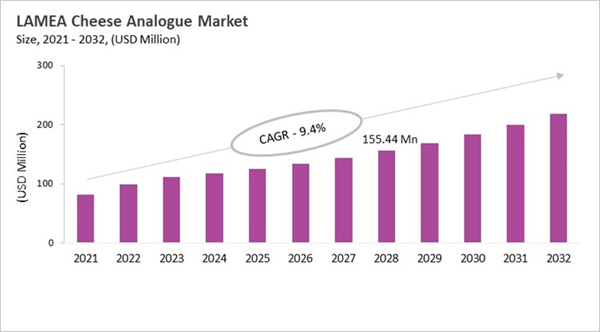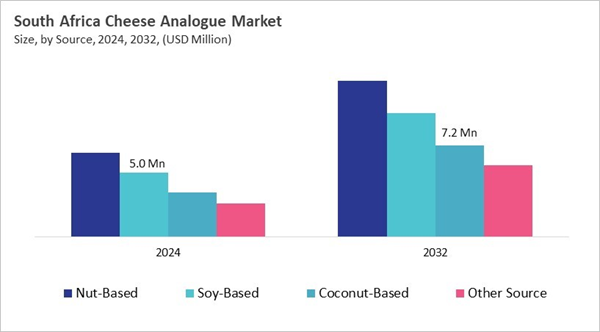The Brazil market dominated the LAMEA Cheese Analogue Market by country in 2024, and is expected to continue to be a dominant market till 2032; thereby, achieving a market value of $37.8 million by 2032. The Argentina market is showcasing a CAGR of 9.5% during 2025-2032. Additionally, the UAE market would register a CAGR of 7.2% during 2025-2032. The Brazil and UAE led the LAMEA Cheese Analogue Market by Country with a market share of 19.8% and 14.6% in 2024.The South Africa market is expected to witness a CAGR of 9.1% during throughout the forecast period.
The cheese substitute market in Latin America, the Middle East, and Africa (LAMEA) has changed over time because of price, eating habits, and rules. In Latin America, schools and bakeries started using plant-oil-based substitutes because of rising costs and an unreliable milk supply. In the Middle East, the spread of fast food and halal certification made mozzarella- and cheddar-like analogues more popular. In Africa, on the other hand, limited cold-chain infrastructure and food security needs made analogues a good choice because they don't need to be refrigerated. Regulations in all areas stressed clear product identity, halal compliance, and consumer protection through clear labeling.
Regulatory transparency, using crops like cowpeas, chickpeas, and maize to innovate local resources, and finding a balance between affordability and lifestyle positioning are all important trends that are affecting the market. Analog cheeses are still important for saving money in schools, bakeries, and restaurants, but cities like São Paulo, Dubai, and Cape Town are also using them as part of their plant-based lifestyles. There is a lot of competition in the market. Large processors meet the needs of institutions, regional companies focus on halal or local products, and multinationals provide advanced ingredients. Distribution has grown from institutional buyers to supermarkets and online shopping. This shows that analogue cheese can be both useful and something to aspire to.
Source Outlook
Based on Source, the market is segmented into Nut-Based, Soy-Based, Coconut-Based, and Other Source. Among various South Africa Cheese Analogue Market by Source; The Nut-Based market achieved a market size of USD $6.6 Million in 2024 and is expected to grow at a CAGR of 8.3 % during the forecast period. The Coconut-Based market is predicted to experience a CAGR of 9.7% throughout the forecast period from (2025 - 2032).Distribution Channel Outlook
Based on Distribution Channel, the market is segmented into Off-trade (Supermarkets & Hypermarkets, Online retail stores, Convenience Stores, and Other Off-trade Type), and On-trade (HoReCa). With a compound annual growth rate (CAGR) of 9.1% over the projection period, the Off-trade Market, dominate the Argentina Cheese Analogue Market by Distribution Channel in 2024 and would be a prominent market until 2032. The On-trade (HoReCa) market is expected to witness a CAGR of 10.1% during 2025-2032.Country Outlook
Brazil is emerging as a key Latin American market for cheese analogues, driven by high lactose intolerance, growing veganism, and rising environmental awareness. Urban centers like São Paulo and Rio de Janeiro lead adoption, with younger demographics and a rising middle class embracing dairy-free options for health, sustainability, and ethical reasons. Government initiatives supporting sustainable food systems and NGO advocacy for plant-based diets reinforce demand. Market trends include artisanal innovations, such as cashew-based cheeses and dairy-free pão de queijo, alongside mainstream retail expansion in chains like Pão de Açúcar and Carrefour. Foodservice adoption is increasing, with vegan pizzas and café offerings gaining popularity. Online platforms further extend accessibility, while multinational brands like Violife and Daiya compete with local startups. Despite price sensitivity, domestic production and culinary creativity are driving broader acceptance and integration into Brazil’s food culture.List of Key Companies Profiled
- Flora Food Group
- Daiya Foods, Inc. (Otsuka Pharmaceutical)
- Miyoko's Creamery
- Follow Your Heart
- Kite Hill
- GOOD PLANeT Foods Inc.
- Danone S.A.
- Tofutti Brands, Inc.
- Nestle S.A.
- Ingredion Incorporated
- Treeline Cheese
Market Report Segmentation
By Distribution Channel
- Off-trade
- Supermarkets & Hypermarkets
- Online retail stores
- Convenience Stores
- Other Off-trade Type
- On-trade (HoReCa)
By Source
- Nut-Based
- Soy-Based
- Coconut-Based
- Other Source
By Form
- Slices
- Blocks/Cubes
- Shred/Grated
- Spreadable
- Other Form
By Category
- Conventional
- Specialty
By Country
- Brazil
- Argentina
- UAE
- Saudi Arabia
- South Africa
- Nigeria
- Rest of LAMEA
Table of Contents
Companies Mentioned
- Flora Food Group
- Daiya Foods, Inc. (Otsuka Pharmaceutical)
- Miyoko's Creamery
- Follow Your Heart
- Kite Hill
- GOOD PLANeT Foods Inc.
- Danone S.A.
- Tofutti Brands, Inc.
- Nestle S.A.
- Ingredion Incorporated
- Treeline Cheese










